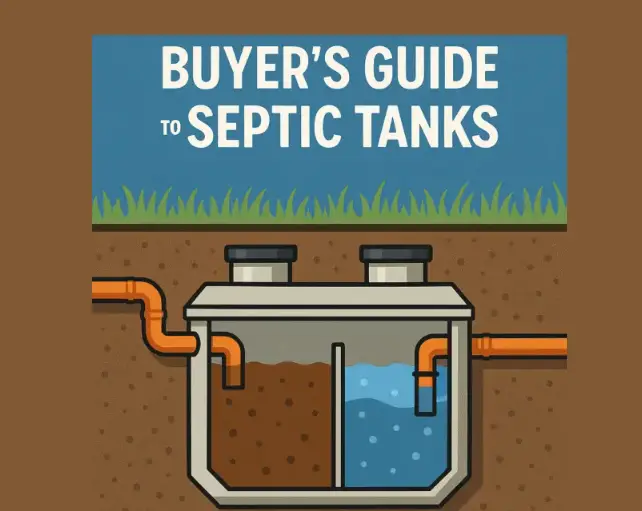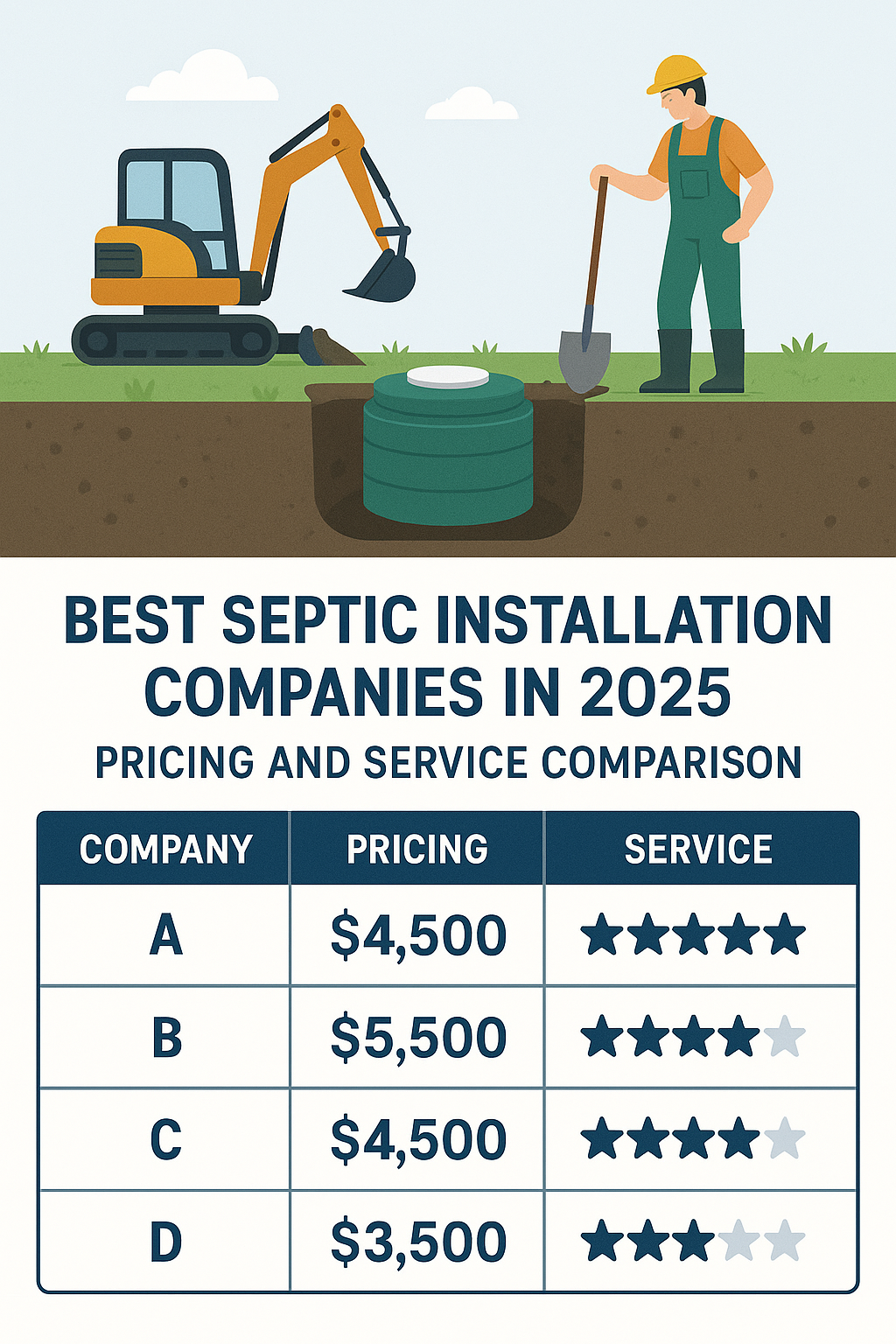That mysterious concrete vault buried in your backyard isn’t just a simple storage container – it’s the unsung hero of your home’s waste management system. Whether you’re building new, replacing an aging tank, or finally understanding what that inspection report meant, choosing the right septic tank can save you thousands in headaches and repair bills down the road.
Your septic system quietly handles one of life’s less glamorous necessities, processing everything that goes down your drains and toilets. But here’s the thing: not all septic tanks are created equal, and picking the wrong one is like choosing a sports car for hauling lumber – it might look good initially, but you’ll regret it when reality hits.
This comprehensive septic tank buying guide cuts through the marketing fluff and gives you the straight facts about what works, what doesn’t, and what you actually need for your specific situation. By the end, you’ll know exactly how to choose a septic tank that’ll serve your family reliably for decades to come.
Understanding Septic Tanks: The Foundation of Your System
Think of a septic tank as your home’s personal wastewater treatment facility. This underground chamber receives all the wastewater from your house, allowing solids to settle at the bottom while oils and grease float to the top. The partially clarified water in the middle layer then flows out to your drain field for final treatment in the soil.
The magic happens through a combination of gravity, beneficial bacteria, and time. Waste separates into three distinct layers: the scum layer on top, the effluent in the middle, and the sludge at the bottom. Bacteria naturally present in human waste break down the organic matter, while the tank’s design ensures proper flow and settling.
Types of Septic Tanks: Material Matters
Concrete Septic Tanks remain the gold standard for durability and longevity. These heavyweight champions can last 30-40 years with proper maintenance, resist shifting soil, and handle heavy loads without batting an eye. The downside? They’re expensive to install due to weight and require careful handling during delivery.
Plastic/Polyethylene Tanks offer the best bang for your buck, especially for smaller households. They’re lightweight, rust-proof, and significantly cheaper than concrete. However, they can shift in unstable soil and may not handle the abuse that concrete tanks shrug off.
Fiberglass Tanks split the difference between concrete and plastic. They won’t crack like concrete or shift like plastic, making them ideal for areas with challenging soil conditions. They’re also resistant to corrosion from acidic waste, though they come with a higher price tag than plastic options.
Steel Tanks are essentially extinct in new installations, and for good reason. They rust, collapse, and generally cause more problems than they solve. If you find one during a property inspection, budget for replacement sooner rather than later.
“I’ve seen homeowners save a few hundred dollars on a plastic tank only to spend thousands fixing foundation issues caused by shifting. The material you choose should match your soil conditions, not just your immediate budget.”
– Marcus Rodriguez, Licensed Septic Installer with 25 years experience
Key Factors to Consider When Buying a Septic Tank
Household Size and Waste Load
Your family size directly impacts the tank size you’ll need, but it’s not just about counting heads. A family of four with teenagers will generate significantly more waste than empty nesters. Consider your family’s growth plans, guest frequency, and water usage habits.
The general rule: plan for 150 gallons per person per day, but add 20% as a safety buffer. Large families, frequent entertainers, or homes with high-efficiency fixtures might need adjustments to this baseline calculation.
Soil Composition and Drainage
Your soil type isn’t just important for your drain field – it affects your tank choice too. Clay soils that retain moisture can cause plastic tanks to float during heavy rains, while sandy soils might allow concrete tanks to settle unevenly.
A proper percolation test during site evaluation will reveal your soil’s drainage characteristics and help determine the best tank material and installation approach for your specific conditions.
Tank Size and Capacity
Bigger isn’t always better, but too small is definitely worse. Most residential tanks range from 750 to 1,500 gallons, with 1,000 gallons being the sweet spot for average families. Oversizing slightly provides a buffer for parties, guests, or increased usage, while undersizing guarantees problems.
Material Durability and Maintenance Needs
Consider your long-term maintenance commitment. Concrete tanks might develop small cracks that need sealing, plastic tanks might need repositioning if they shift, and fiberglass tanks generally require the least ongoing attention.
Factor in your local climate too. Extreme temperature fluctuations, freeze-thaw cycles, and soil chemistry all impact material longevity differently.
Local Regulations and Permits
Your local health department isn’t trying to make your life difficult – they’re ensuring your system protects groundwater and public health. Regulations vary significantly by location, covering everything from minimum tank sizes to approved materials and installation requirements.
Some areas require specific tank certifications, while others mandate certain materials based on local soil conditions. Always check local codes before purchasing, as a non-compliant tank is an expensive paperweight.
Budget and Long-Term Cost
The cheapest tank upfront often costs the most over time. Factor in installation costs, expected lifespan, and maintenance requirements when calculating true cost. A $500 plastic tank that needs replacing in 15 years might cost more than a $2,000 concrete tank that lasts 40 years.
Septic Tank Reviews: Top Picks for 2025
Best Overall Septic Tank: Precast Concrete 1,000-Gallon
For most families, a quality precast concrete tank hits the sweet spot of durability, capacity, and value. These tanks typically feature reinforced construction, proper inlet/outlet configurations, and access ports for maintenance. Expect to pay $1,200-$2,000 for the tank itself, plus installation costs.
Best Budget Septic Tank: High-Density Polyethylene 1,000-Gallon
Plastic tanks from reputable manufacturers offer excellent value for stable soil conditions. Look for tanks with ribbed construction for strength and proper baffle systems. Budget around $600-$1,200 for the tank, making total project costs significantly lower than concrete options.
Best for Large Households: 1,500-Gallon Concrete Tank
Families of six or more, or homes with high water usage, benefit from the extra capacity. The additional volume provides more settling time and reduces pumping frequency, offsetting the higher initial cost through reduced maintenance.
Best Eco-Friendly Option: Fiberglass Tank with Advanced Treatment
Modern fiberglass tanks often incorporate advanced treatment features like additional chambers or enhanced settling areas. While pricier initially, they can improve effluent quality and may allow for alternative drain field designs in challenging locations.
Editor’s Choice: Concrete Tank with Fiberglass Lid
This hybrid approach combines concrete’s durability with fiberglass’s corrosion resistance where it matters most. The fiberglass lid won’t deteriorate from exposure to septic gases, while the concrete body provides stability and longevity.
“The best septic tank is the one that’s properly sized for your household and correctly installed for your soil conditions. I’ve seen expensive tanks fail due to poor installation and budget tanks perform beautifully when everything’s done right.”
– Sarah Chen, Environmental Engineer and Septic System Designer
Installation Considerations
DIY vs. Professional Installation
Unless you own an excavator and have experience with septic systems, tank installation is firmly in professional territory. The precision required for proper grading, bedding, and connection to existing systems makes this a job for licensed contractors.
DIY enthusiasts can handle site preparation, permit applications, and system design research, but leave the actual installation to the pros. The cost savings rarely justify the risk of improper installation.
Installation Costs and Timeline
Complete septic tank installation typically runs $3,000-$7,000, including the tank, excavation, bedding material, connections, and backfilling. Timeline depends on soil conditions, weather, and permit processing, but most installations complete within 2-3 days once work begins.
Site preparation might add time if access is difficult or existing systems need removal. Factor in 2-4 weeks for permits and scheduling with contractors during busy seasons.
Importance of Licensed Contractors
Licensed septic contractors carry insurance, understand local codes, and warranty their work. They also handle permit applications and inspections, ensuring your system meets all requirements. The modest premium for licensed work pays dividends in peace of mind and legal compliance.
Maintenance and Longevity Tips
Routine Pumping Schedules
Most tanks need pumping every 3-5 years, but your specific schedule depends on tank size, household size, and usage patterns. Larger tanks serving smaller families can go longer between pumpings, while busy households might need annual service.
Don’t wait for problems to develop. Regular pumping prevents solids from reaching your drain field, where they can cause expensive damage.
Avoiding Harmful Substances
Your septic tank isn’t a garbage disposal. Avoid flushing medications, chemicals, grease, non-biodegradable items, and excessive amounts of household cleaners. These substances can kill beneficial bacteria or accumulate in ways that disrupt normal operation.
Signs Your Tank Needs Attention
Watch for slow drains, sewage odors, wet spots over the tank area, or backup into fixtures. These symptoms often indicate the need for pumping or more serious system problems requiring professional attention.
Annual visual inspections of accessible components can catch problems early when they’re cheaper and easier to fix.
Frequently Asked Questions
How long do septic tanks last?
Concrete tanks typically last 30-40 years, fiberglass tanks 20-30 years, and plastic tanks 15-25 years. Proper maintenance and installation quality significantly impact lifespan.
Can I upgrade to a larger tank later?
Yes, but it requires excavation and essentially a complete reinstallation. It’s much more cost-effective to size correctly initially than to upgrade later.
Do I need special permits for tank replacement?
Most areas require permits for septic tank installation or replacement. Your contractor should handle permit applications, but verify this is included in their scope of work.
What’s the difference between a septic tank and a cesspool?
Septic tanks treat waste and discharge effluent to a drain field, while cesspools simply collect waste in a lined pit. Modern codes require septic systems rather than cesspools in most areas.
“The most expensive septic tank is the one that fails prematurely. Invest in quality materials, proper installation, and regular maintenance. Your future self will thank you when neighbors are dealing with sewage backups and you’re not.”
– Tom Anderson, Master Plumber and Septic System Specialist
Making Your Final Decision
Choosing the right septic tank comes down to matching your specific needs with the right material and size. Consider your soil conditions, household size, local regulations, and long-term budget when making your decision.
Remember that the tank is just one component of your septic system. The best tank in the world won’t help if your drain field is poorly designed or your soil conditions are challenging. Work with experienced professionals who can evaluate your entire system as a cohesive unit.
Don’t rush this decision. A septic tank should serve your family for decades, making the upfront investment in quality materials and professional installation worthwhile. Take time to get multiple quotes, verify contractor licenses, and understand exactly what’s included in your project scope.
Most importantly, remember that proper maintenance matters more than brand names or premium features. A basic tank that’s properly maintained will outperform an expensive tank that’s neglected. Factor ongoing maintenance costs and requirements into your decision-making process.
Whether you’re building new or replacing an existing system, consulting with a qualified septic professional ensures you get a system designed for your specific situation. They can evaluate your soil, assess your needs, and recommend the best combination of tank material, size, and installation approach for your property.




